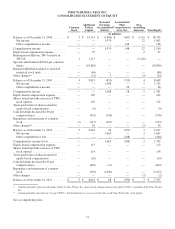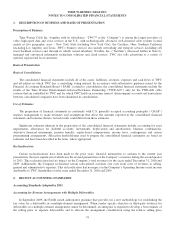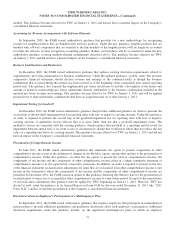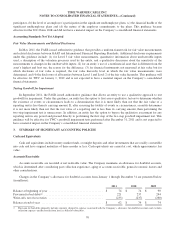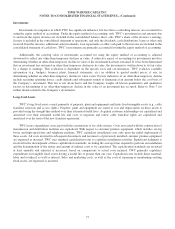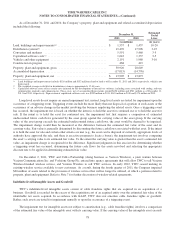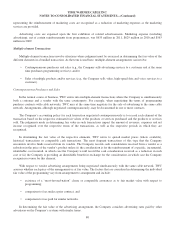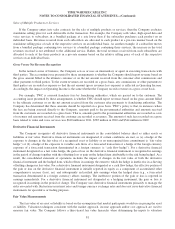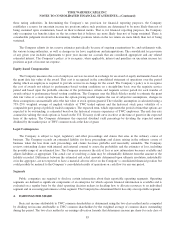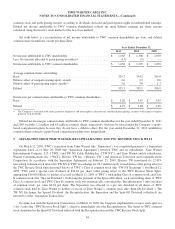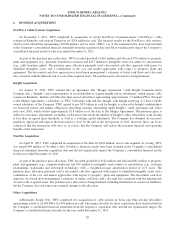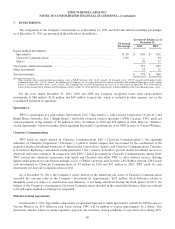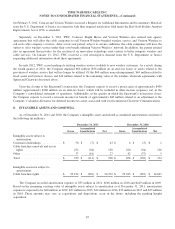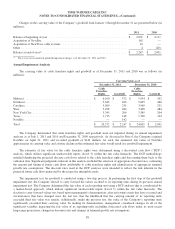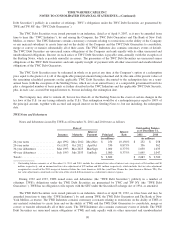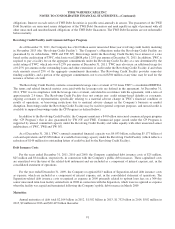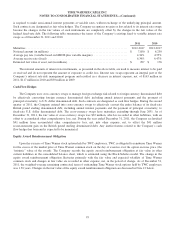Time Warner Cable 2011 Annual Report Download - page 91
Download and view the complete annual report
Please find page 91 of the 2011 Time Warner Cable annual report below. You can navigate through the pages in the report by either clicking on the pages listed below, or by using the keyword search tool below to find specific information within the annual report.TIME WARNER CABLE INC.
NOTES TO CONSOLIDATED FINANCIAL STATEMENTS—(Continued)
these taxing authorities. In determining the Company’s tax provision for financial reporting purposes, the Company
establishes a reserve for uncertain income tax positions unless such positions are determined to be more likely than not of
being sustained upon examination, based on their technical merits. That is, for financial reporting purposes, the Company
only recognizes tax benefits taken on the tax return that it believes are more likely than not of being sustained. There is
considerable judgment involved in determining whether positions taken on the tax return are more likely than not of being
sustained.
The Company adjusts its tax reserve estimates periodically because of ongoing examinations by, and settlements with,
the various taxing authorities, as well as changes in tax laws, regulations and interpretations. The consolidated tax provision
of any given year includes adjustments to prior year income tax accruals that are considered appropriate and any related
estimated interest. The Company’s policy is to recognize, when applicable, interest and penalties on uncertain income tax
positions as part of income tax expense.
Equity-based Compensation
The Company measures the cost of employee services received in exchange for an award of equity instruments based on
the grant date fair value of the award. That cost is recognized in the consolidated statement of operations over the period
during which an employee is required to provide service in exchange for the award. The Company’s policy is to recognize
the cost of awards not subject to performance-based vesting conditions on a straight-line basis over the requisite service
period and based upon the probable outcome of the performance criteria and requisite service period for each tranche of
awards subject to performance-based vesting conditions. The Company uses the Black-Scholes model to estimate the grant
date fair value of a stock option. Because the option-pricing model requires the use of subjective assumptions, changes in
these assumptions can materially affect the fair value of stock options granted. The volatility assumption is calculated using a
75%-25% weighted average of implied volatility of TWC traded options and the historical stock price volatility of a
comparable peer group of publicly traded companies. The expected term, which represents the period of time that options are
expected to be outstanding, is estimated based on the historical exercise experience of TWC employees. The risk-free rate
assumed in valuing the stock options is based on the U.S. Treasury yield curve in effect at the time of grant for the expected
term of the option. The Company determines the expected dividend yield percentage by dividing the expected annual
dividend by the market price of TWC common stock at the date of grant.
Legal Contingencies
The Company is subject to legal, regulatory and other proceedings and claims that arise in the ordinary course of
business. The Company records an estimated liability for those proceedings and claims arising in the ordinary course of
business when the loss from such proceedings and claims becomes probable and reasonably estimable. The Company
reviews outstanding claims with internal and external counsel to assess the probability and the estimates of loss, including
the possible range of an estimated loss. The Company reassesses the risk of loss as new information becomes available and
adjusts liabilities as appropriate. The actual cost of resolving a claim may be substantially different from the amount of the
liability recorded. Differences between the estimated and actual amounts determined upon ultimate resolution, individually
or in the aggregate, are not expected to have a material adverse effect on the Company’s consolidated financial position but
could possibly be material to the Company’s consolidated results of operations or cash flow for any one period.
Segments
Public companies are required to disclose certain information about their reportable operating segments. Operating
segments are defined as significant components of an enterprise for which separate financial information is available and is
evaluated on a regular basis by the chief operating decision makers in deciding how to allocate resources to an individual
segment and in assessing performance of the segment. The Company has determined that it has only one reportable segment.
4. EARNINGS PER SHARE
Basic net income attributable to TWC common shareholders is determined using the two-class method and is computed
by dividing net income attributable to TWC common shareholders by the weighted average of common shares outstanding
during the period. The two-class method is an earnings allocation formula that determines income per share for each class of
83


